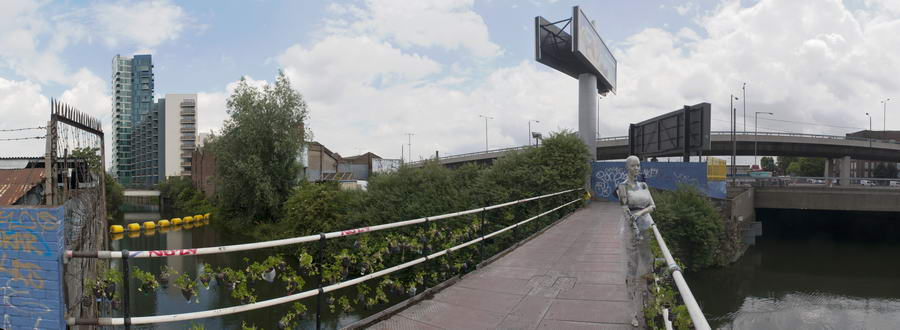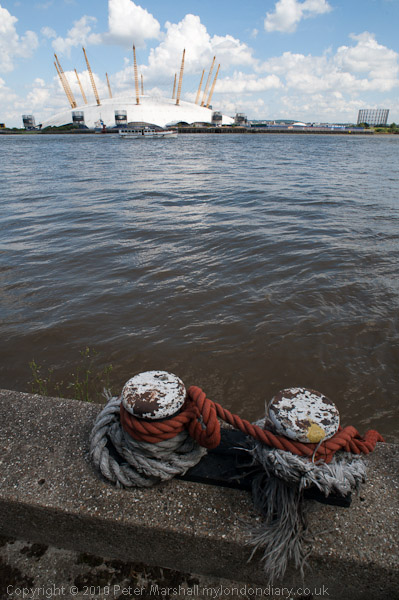One of the reasons I’ve been getting a little behind in posting about my own work here is that I’ve been busy putting the finishing touches to my first book of pictures of the Olympic area (It’s now completed and I’m waiting with interest to see it in print.) The Lea Valley around London’s second river, the Lea, is an area I started to photograph in the 1980s and have continued to go back to occasionally ever since.
In the early 1980s my work on Hull had been accepted for a major museum show there and I was looking to repeat my success in London. Possibly the reason it didn’t happen was that the subject I chose for my next major project was the Lea Valley, which at that time absolutely nobody other than me seemed to have an interest in.
Then I could walk along the Northern Outfall Sewer for several miles and have the area completely to myself, and the paths along the various waterways of the back rivers crossing Stratford Marsh would, at least in the close season for fishing, be totally deserted.
Things have changed drastically with the success of the London Olympics bid, and last Tuesday I had to keep stopping as I rode along the path on top of the sewer, long since re-branded as the ‘Greenway’ which was crowded with various groups of visitors.
Thanks to the Olympics, the area has also been noticed by the London Festival of Architecture and was the site of an ‘urban gardening’ intervention by students from the University of Innsbruck, Austria.

Urban gardening alongside the Lea Navigation by Bow Flyover
I’d gone there to continue my series of images of the Olympic area, where I’ve been trying to make roughly monthly visits to see the progress on the site.

Olympic stadium, Greenway and View Tube
and also to meet an artist friend with whom I’m working on a joint project with us both producing images from the same areas of London – and the Olympic site is one we’ve chosen. We’re looking for a venue in London for an exhibition of our joint work, though so far without success.
I spent around an hour there taking photographs, particularly some panoramas – like the one above. I’d hope to be able to photograph from the viewing platform there, but unfortunately it isn’t available when school groups are using the classroom, so this time I couldn’t do so.
But I had thought to bring a monopod with me, virtually a necessity to take pictures above the temporary fencing that lines the area now. The mesh of this isn’t particularly fine, but you can’t put any Nikon DSLR lens through it and at six foot and a couple of inches its hard to photograph over unless you are rather tall.
The monopod is good for panoramas anyway as you can rotate the camera while keeping it in the same position (though I’d forgotten my attachment which enables rotation around the lens near nodal point, which is essential if you have any close objects in the frame.) But unfortunately it only reaches up to a little over five foot, so I had to hold it well off the ground so that the camera had a clear view over the fence.
This introduces other problems. It’s hard to keep the monopod in exactly the same position between exposures and the camera may actually be too high to reach to fire the shutter. For a single exposure the self-timer can deal with the second problem, but if you want to make multiple exposures while rotating the camera in order to make a panorama it makes getting the camera back into the same position problematic.
So although it might have been nice to lift the camera higher for some shots, in practice when making panoramas I was limited to the height I could reach to the shutter release. And making panoramas works best when I can work either with the foot of the monopod firmly on the ground, or with some part of it braced against some solid structure.
For the panoramic images I decided to use a fixed 20mm lens, a Nikon f2.8. It has reasonably low distortion and cuts out one possibility – altering the foal length that can make multiple images with wit zooms hard to stitch.To make panoramas that are easy to make and print, I want to stick to using a single row of images, and a relatively wide lens produces images that work together with those taken with my swing lens film cameras which have lenses of roughly 26mm focal length. Y
However carefully you work, the geometry means you lose some vertical coverage when stitching images (the actual amount depends on the angular overlap between images) and starting from 20mm. Screwing the camera directly to the top of the monopod means using it in landscape mode, which isn’t ideal, but is considerably simpler.
What I would welcome is a more compact monopod. The cheap unbranded model I have is reasonably light and sturdy, has rapid locks for quick and reliable extension and extends at maximum stretch to hold the camera exactly at my eye level, but is around 17 inches when collapsed, too long to fit my camera bag, though it does just slip in at an angle to the bag on my Brompton folding bike which I often ride in London. But looking through the various models available (ranging in price from a tenner up to around £250) I can’t really see anything better.
And there is of course nothing better than PTGui for stitching the images. You can see the above pictures and a few more on My London Diary, where there are also some more non-panoramic images of the urban gardening, as well as from the Olympic site and my travels back into the centre of London by a rather roundabout route on the Brompton.

I didn’t cross the river here at Blackwall, but cycled down to the foot tunnel at Greenwich
I prefer Autopano for stitching for features and power, although it is more expensive than ptGUI.
Not a great difference in price. I don’t think I’ve tried Autopano, certainly not recently. I use the Pro version which I think costs more than the standard Autopano which I think would do all I need. If I needed to buy now I’d certainly consider it.
A few years ago I did a review comparing many different programs, and then PTGui certainly stood out, doing better than anything else including some software that cost more than 5 times as much. There were several programs that seemed so poor they didn’t even get a mention.
But things change and Autopano certainly looks good – the Paris 26 Gigapixels image is impressive!
When I tested in the past I found ptgui to be great for architectural shots on tripod, but Autopano seems to work better where ptgui doesn’t when working out control points, and it seems to do better for me when stitching handheld shots (which for me is most of the time).
Interesting as a lot of what I do is handheld. Mostly they stitch well in PTGui, but sometimes not. Certainly it is usually better if I use a monopod.